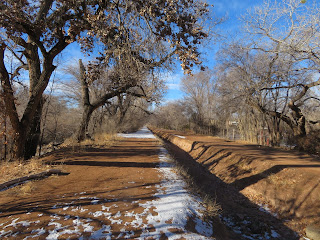I blog because Corrales scenery is free and I am in a year-long, and boring pandemic lock-down. I am not a professional writer or photographer (not too hard to tell). However, I know a few things about nature, and as I learn I like to share. I specialize in watching the changes of nature over the yearly cycle. This is the reason for the title (Phenology)
The reason I'm writing this blurb, is that over the course of the last year, the stats of this blog site tell me that over half of all readers of this blog are local residents on Nextdoor app. So most already know Corrales is great. Everyone else just want to see cool pictures. The vast internet universe can document the most obscure and esoteric parts of nature watching but this scale of information production can have a nasty downside too. The internet has a bad habit of trending everything towards the mean. People expect to see certain things from a small blog about nature. Not going to happen. I write what I like (for about 2 hours a day).
However, I still appreciate those who also like what I cover. It's even greater if people leave a comment. Special thanks to those who have signed up for updates. That number has doubled over the the last 2 days! (There are now two people). Thank you, really.
The freeze last night was not actually very harsh (I saw no new tree branches snapped off). But the ducks appear to have been caught off guard. They don't like ice, preferring open, water. These tracks show some ducks waddling across thin ice during a snowfall. Quite a few of them, too.
In close up, you can see the march through the slush. Ducks are able to move on "land, sea, and air" but they are not comfortable outside of very specific environments (six inches of water). They are strong fliers, but only over short, frantic flights. They stand on land well, but these tracks show the "pigeon-toed" trade-off that having big flippers for feet require.
For humans, a different big problem after a snowstorm is the ice that forms when many clomping human feet will compress the snow into an icy sheet that then freezes into a slippery trap. This ice lasts a long time after the uncompressed snow has vanished. Many broken hips and bruises across the United States will be a hidden epidemic this week. Still, the large ice crystals that formed from the slow freezing are pretty, seen first thing in the morning.
The great blue heron is in his usual perch this morning. I've learnt the bigger birds definitely do not like being stared at with a camera for very long. So I try to get my picture and move on quickly. Because of that, I often do not get a very staged picture, which is good. Still, it shows the complexity that is below the unruffled feathery exterior.
I was only able to get one picture of this hawk. Some people think this is an unusual species, but I think it is just a red-tailed hawk. The argument is raging on Inaturalist now. Birders are strange people.
The thick growth between clear ditch and the Sandoval lateral is important habitat for birds. The recent cutting of the willow displaced a small family of snipes, which have moved about 600 feet up the ditch. This photo also shows how one side of the ditch receives much more shade that the other. The slower melting snow is likely to help hydration of the dry soil on the eastern side for a few more days, which could be crucial for lizard and amphibian development.










Hi, I enjoy your photos very much. I'm in Corrales; are the blue birds here now? Thank you for sharing.
ReplyDelete